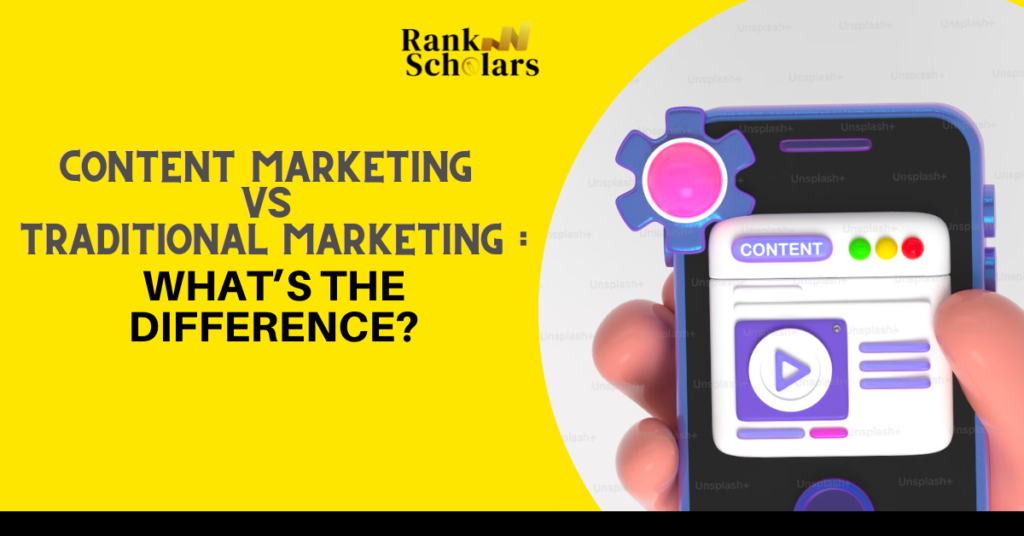With over 5.35 billion internet users, capturing the attention of the target audience has become increasingly challenging. But content marketing offers a powerful solution to this. It’s more than just creating content, it’s about producing valuable, relevant, and engaging material that resonates with your audience’s needs and preferences.
Think about your own online behaviour. When was the last time you made a purchasing decision without researching or reading reviews? Your customers are no different. They crave informative, entertaining, or educational content that solves their questions or satisfies their curiosity.
In this blog, we’ve explored several steps on how to use content marketing to grow your business. So, if you’re ready to take your business to the next level and attract, engage, and convert more customers, let’s dive in.
Benefits of Content Marketing
Content marketing offers plenty of benefits for businesses looking to boost their online presence and engage with their audience. Following are some of the advantages.
Improves Search Engine Rankings
Content marketing plays a vital role in enhancing a website’s visibility on search engines. Creating high-quality and relevant content helps businesses target specific keywords and topics that align with their target audience’s interests and search queries.
Search engines prioritize high-quality content when determining which websites to display in search results. By publishing valuable content that provides solutions to users’ queries, businesses can increase their visibility in search engine results pages (SERPs).
Increased Conversion Rates
Content marketing serves as a powerful tool for guiding leads through the sales funnel.
High-quality content that educates, entertains, or solves a problem attracts visitors and also builds trust and credibility with the audience.
By providing valuable information through blog posts, in-depth guides, case studies, or interactive webinars, businesses can tailor their content to cater to the specific needs and preferences of their audience. This results in enhancing conversion rates by delivering relevant messages to the right people at the right time.
Improves Relationships with Prospects & Clients
Content marketing goes beyond just attracting new leads and converting them into customers, it helps to build long-term relationships with prospects and clients.
Creating valuable and relevant content helps businesses to demonstrate their expertise, industry knowledge, and issues as per the audience’s needs. By prioritizing customer-centric content strategies, businesses can cultivate long-term relationships built on mutual trust and satisfaction.
Also Read: 13 Best SaaS Content Marketing Agencies To Generate Leads
Types of Content Marketing
There are several types of content marketing available. Focus on the ones that align well with your brand rather than attempting to try them all. Following are 7 types of content marketing you may look up to
1. Online Content Marketing
With over 5.35 billion internet users in 2024, online content marketing leads to boost business growth. Online content marketing involves creating and distributing valuable content across various digital platforms, including websites, blogs, and online publications.
A wide range of formats are crafted to the audience’s demands and interests, from instructional articles and in-depth guides to case studies and whitepapers in online content marketing.
Online content serves as a valuable resource for users seeking information or solutions related to the industry, products, or services offered by the business.
It’s a valuable resource for educating prospects, addressing their pain points, and guiding them through the buyer’s journey. This ultimately drives conversions and creates long-term relationships with customers.
2. Social Media Content Marketing
According to Statista, in 2024, over 5.04 billion people use social media worldwide. And this makes social media content one of the most powerful marketing tools.
Social media marketing involves crafting and sharing content on platforms like Facebook, Instagram, and Twitter to engage with an audience and promote a brand.
By sharing images, videos, infographics, polls, and user-generated content, businesses can interact with their followers in real time.
For example, a fitness brand could post workout routines and motivational quotes on Instagram to inspire fitness enthusiasts. A travel agency might share stunning destination photos and travel tips on Facebook, inspiring adventure-seekers to plan their next getaway.
3. Infographic Content Marketing
Infographic content marketing involves visual storytelling to simplify complex information or data in a visually appealing and easily digestible way. Infographics combine text, graphics, and images to convey ideas or statistics in a concise and engaging manner.
Infographics are not only informative but also entertaining sparking curiosity and engagement with the audience.
They are highly shareable across various digital platforms, including websites, mail marketing, and social media, making them an effective tool for increasing brand visibility and driving traffic.
In short, infographic content marketing offers a versatile and impactful approach to conveying information, engaging audiences, and enhancing brand awareness to the audience.
4. Blog Content Marketing
Brands that use blog content marketing see 13 times more ROI than the ones that don’t. Blogging is one of the commonly used marketing strategies businesses use to attract their target audience.
These blog posts cover a wide array of topics, ranging from industry trends and insights to product updates and customer stories.
Blogs provide a platform for businesses to share their expertise, address customer pain points, and showcase their unique perspective, ultimately driving brand awareness and loyalty.
Blogs offer opportunities for interaction through comments, social sharing, and subscriptions. Overall, blog content marketing is a powerful tool for businesses to educate, inform, and connect with their audience in a meaningful way.
Also Read: 30 FREE Content Writing Tools For Your Blog
5. Paid Ad Content Marketing
Paid ad content marketing involves promoting content through paid advertising channels such as Google Ads, social media ads, sponsored content, and native advertising. This type of content marketing allows businesses to target specific demographics, interests, and behaviors to reach their ideal audience.
Paid ads use different formats, including text ads, display ads, video ads, and sponsored content placements, offering flexibility in reaching and engaging with potential customers across different platforms.
It can drive traffic to landing pages, promote product launches, and increase brand visibility in competitive markets.
Paid ad content marketing enables businesses to track and measure the performance of their campaigns, optimizing them for better results, and maximizing return on investment (ROI).
6. Podcast Content Marketing
Podcasts have become a popular content marketing format in recent years with 504.9 million podcast listeners worldwide in 2024. Podcasts can cover a wide range of topics relevant to their industry, products, or services, businesses can connect with their audience in a more personal and intimate way.
By sharing industry insights, conducting interviews with experts, or delivering educational content, podcasts offer an opportunity to showcase expertise, build trust & credibility, and establish authority within a niche.
Podcasts provide a platform for businesses to humanize their brand, share authentic stories, and connect with listeners on a more emotional level. This ultimately drives engagement and conversions.
7. Video Content Marketing
By 2025, YouTube users are expected to reach 2.85 billion so investing in video content creation is one of the most effective marketing strategies.
Video content, whether it’s product demos, how-to guides, behind-the-scenes glimpses, customer testimonials, or engaging narratives, offers a compelling way to convey messages and showcase offerings.
With the rise of live streaming and interactive video formats, brands can form connections and meaningful engagement with their audience. Video content has the potential to significantly impact purchasing decisions, as consumers are more likely to remember and act upon video messages compared to other forms of content.
Videos are also highly shareable across social media platforms, making them an effective tool for increasing brand visibility and reaching new audiences.
How to Get Started with Content Marketing?
Below are several ways you can get started with content marketing to reach your business goals.
Identify Your Target Audience
Identifying the target audience is a critical stage of your content marketing strategy. You can create the most ecstatic content, but it is worthless if it doesn’t reach the ideal audience. Understanding who your audience is allows you to craft your content to their specific needs, interests, and preferences.
Start by conducting thorough research to gather demographic information such as age, gender, location, and income level. You can also dive deep to uncover psychographic factors such as interests, values, attitudes, and pain points.
This understanding of your audience enables you to create content that resonates with them on a deeper level, encouraging stronger connections and engagement.
By identifying your target audience, you can tailor your messaging, content formats, and distribution channels to effectively reach and engage the right people with the right content at the right time.
Conduct Keyword Research
Conducting keyword research is a fundamental step in any content marketing strategy, as it maximizes your content’s visibility and relevance to your target audience. For instance, it helps you to create kinds of content by identifying the terms and phrases your target audience is using when searching for information relevant to your business.
You can use tools such as Google Keyword Planner, Semrush Keyword Magic Tool, or Ahrefs Keyword Explorer to gain valuable insights into search volume, competition level, and keyword trends.
Focus on selecting keywords that align with your business goals and target audience preferences, aiming for a balance between high search volume and low competition. Use long-tail keywords and semantic variations to capture more targeted traffic.
It may seem daunting at first, but conducting keyword research allows you to optimize your content to include relevant keywords strategically, improving its visibility in search engine results pages (SERPs) and driving organic traffic to your website.
Identify and Allocate Resources
After identifying the target audience and conducting keyword research, the next step of the content marketing strategy is producing the content. It is essential to look into the human, financial, and technological resources that are necessary to execute your content marketing plan effectively.
This may include allocating a budget for content creation, hiring skilled writers, designers, or videographers, and investing in tools and software for content management, analytics, and distribution.
You can also consider the time and effort required from your internal team or external partners to research, plan, create, and promote content consistently. By accurately assessing and allocating resources upfront, you can ensure that your content marketing efforts are positioned for success.
A clear understanding of available resources helps you to set realistic goals, prioritize initiatives, and maintain a sustainable content production schedule.
Create a Content Calendar
A content calendar serves as a roadmap for your content creation efforts, helping you plan, schedule, and manage your content effectively. To create a content calendar, identify your overarching goals and target audiences’ interests, pain points, and preferences.
Based on the information, brainstorm content ideas and create content about your product or service. Outline a schedule for publishing content, considering factors such as content types, formats, and distribution channels.
Include important dates, events, and holidays relevant to your industry or audience to capitalize on timely opportunities. Create specific timeframes for content ideation, creation, review, and publication to ensure a consistent flow of content.
As you populate your calendar with content ideas and deadlines, stay flexible for changes and adjustments based on the latest trends, audience feedback, or shifting business priorities. By having a well-organized content calendar in place, you can maximize the impact of your content marketing efforts.
Produce Content
Now that the foundation steps are done it’s time to produce content. One thing to keep in mind in this step is to create for people, not for search engines. The approach behind it is that it is people who resonate with the content enough to engage, share, and take action.
So use your research to focus on providing value, solving problems, and addressing the needs of your audience. Create relevant content that is informative, engaging, and visually appealing.
Use a consistent tone and style that reflects your brand’s personality and values. Collaborate with talented writers, designers, videographers, and other creatives, or thought leaders to bring your content ideas to life.
Use the information from your research and produce content that is compelling for the audience as well as for search engines to improve its discoverability. By producing such content, you can effectively engage and build meaningful connections with your target market.
Also Read: How To Humanize AI Content (10 Ways + Tools)
Promote to Your Target Market
After you’ve created valuable and relevant content, it’s time to distribute it through various channels to maximize its visibility and engagement. Social media platforms like Facebook, Twitter, LinkedIn, and Instagram offer effective channels for sharing content with your audience.
Customize your messaging and content format per each platform to optimize engagement and reach. Email marketing allows you to deliver content directly to your subscribers’ inboxes, establishing a close relationship and encouraging repeat engagement.
Collaborating with influencers or industry partners can also amplify your content’s reach and credibility by leveraging their existing audience and networks. Paid advertising, such as Google Ads or social media ads, provides targeted exposure to specific demographics or interest groups, driving traffic and conversions.
Promoting your content to your target market across multiple channels allows you to increase brand awareness, drive traffic, and ultimately, achieve your content marketing goals.
Measure Results
Measuring the results of your content marketing efforts helps to evaluate the effectiveness of your strategy and if required, improvement can be made.
Google Analytics is one such tool that provides valuable insights into website traffic, user behavior, and conversion metrics. For social media analytics tools like Hootsuite, Sprout Social, or Buffer allow you to monitor engagement metrics such as likes, shares, comments, and clicks across various social media channels.
Besides, content management systems (CMS) like WordPress, Drupal, or Joomla often provide built-in analytics features to track content performance within your website. These features enable you to monitor metrics such as page views, top-performing content, and user engagement directly from your CMS dashboard.
You can assess the success of your content marketing campaigns thoroughly by combining these methods and tools.
Conclusion
Content marketing is an unquestionable part when it comes to the success of businesses. And through this blog, you now have learned how to use content marketing to grow your business.
Use the information that you gathered through research and create valuable content to deliver it across various channels, attracting, and converting prospects into loyal customers. With a strategic approach to content marketing, you can efficiently accomplish your business objectives and drive sustained growth.

Sahanaj is a content writer who is passionate about turning ideas into words that inspire positive change.




